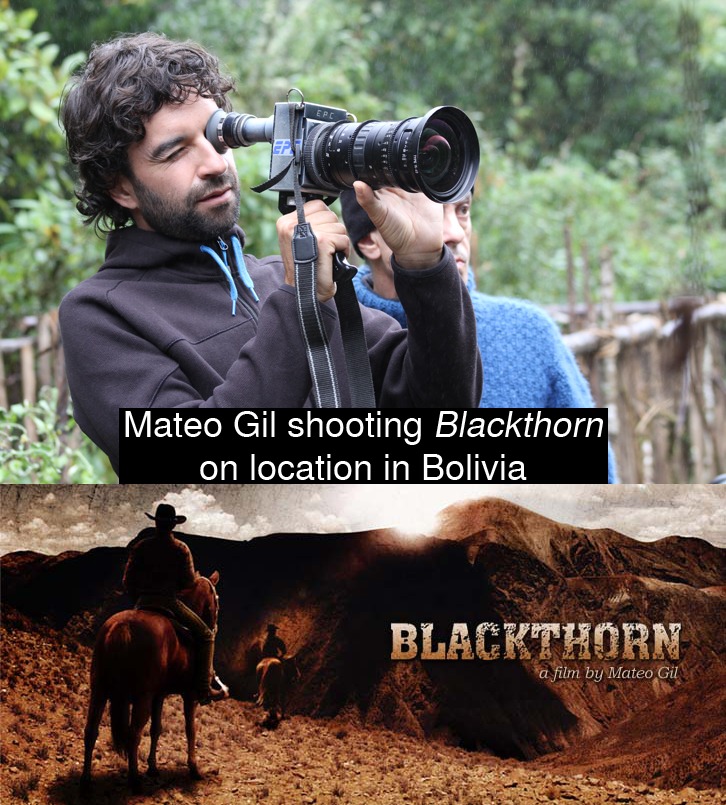 Who: Mateo Gil is a Spain-based filmmaker whose latest feature imagines the later years of American outlaw Butch Cassidy — that is, if he had survived his alleged death in 1908. Cassidy was born Robert LeRoy Parker in Utah in 1866, and formed “The Wild Bunch” gang before teaming with one Harry Longabaugh — also known as “The Sundance Kid.” Over more than a decade, the two men would carry out a string of train and bank robberies, and eventually depart for South America accompanied by one Etta Place. Then, after a crime spree in Argentina and finding refuge in Chile, Place departed back to America, while Cassidy and Longabaugh both remained in Bolivia. It was in the early hours of November 6th 1908 that the two outlaws were reportedly killed at a boarding house in the small town of San Vicente, after a shootout with local authorities. These events were previously dramatized in 1969’s Butch Cassidy and the Sundance Kid, with all Bolivian scenes filmed in Mexico. Blackthorn was written by Miguel Barros, who brought the project to Gil after retracing Cassidy’s
Who: Mateo Gil is a Spain-based filmmaker whose latest feature imagines the later years of American outlaw Butch Cassidy — that is, if he had survived his alleged death in 1908. Cassidy was born Robert LeRoy Parker in Utah in 1866, and formed “The Wild Bunch” gang before teaming with one Harry Longabaugh — also known as “The Sundance Kid.” Over more than a decade, the two men would carry out a string of train and bank robberies, and eventually depart for South America accompanied by one Etta Place. Then, after a crime spree in Argentina and finding refuge in Chile, Place departed back to America, while Cassidy and Longabaugh both remained in Bolivia. It was in the early hours of November 6th 1908 that the two outlaws were reportedly killed at a boarding house in the small town of San Vicente, after a shootout with local authorities. These events were previously dramatized in 1969’s Butch Cassidy and the Sundance Kid, with all Bolivian scenes filmed in Mexico. Blackthorn was written by Miguel Barros, who brought the project to Gil after retracing Cassidy’s 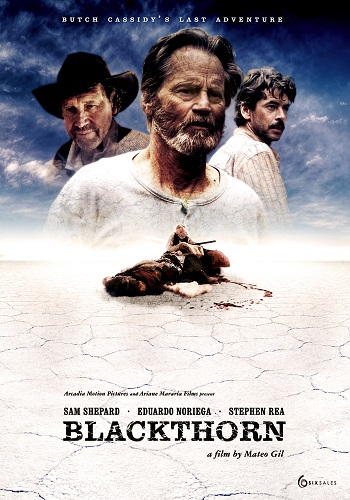 steps across Argentina, Chile and Bolivia, and being inspired to make a film about an outlaw whose 1908 death has been questioned over the past century. In 1991, an exhumation of Cassidy & Longabaugh’s reputed grave site in San Vicente failed to turn up the remains of either man. Gil’s film takes place in 1927, with Sam Shepard’s 61 year-old Cassidy having spent the past 19 years living under the name “James Blackthorn” on a secluded Bolivian ranch. One day, Cassidy decides to finally leave and visit his family in the U.S., but soon meets young on-the-run engineer Eduardo Apocada, who tells Cassidy that he has robbed $50,000 from a tin mine owned by Simón Patiño — the wealthiest man in Bolivia. Cassidy cuts a deal with Apocada for 50% of the loot, if they can evade the posse that’s after the young Spaniard — a posse which turns out to be a group of miners from a collective Apocada ripped off. Throughout the film, Cassidy also flashes back to his years riding with the Sundance Kid, and their run-ins with a Pinkerton agent named Mackinley, played by Sephen Rea. With Cassidy now out of hiding, Mackinley is drawn to the hunt once more. Gil shot the film entirely on location in the high altitudes of Bolivia, only using limited digital editing to erase some modern skyline items in his urban locales — a technique used in the big budget Gil-written film Agora, which was set in Egypt, but shot in Malta.
steps across Argentina, Chile and Bolivia, and being inspired to make a film about an outlaw whose 1908 death has been questioned over the past century. In 1991, an exhumation of Cassidy & Longabaugh’s reputed grave site in San Vicente failed to turn up the remains of either man. Gil’s film takes place in 1927, with Sam Shepard’s 61 year-old Cassidy having spent the past 19 years living under the name “James Blackthorn” on a secluded Bolivian ranch. One day, Cassidy decides to finally leave and visit his family in the U.S., but soon meets young on-the-run engineer Eduardo Apocada, who tells Cassidy that he has robbed $50,000 from a tin mine owned by Simón Patiño — the wealthiest man in Bolivia. Cassidy cuts a deal with Apocada for 50% of the loot, if they can evade the posse that’s after the young Spaniard — a posse which turns out to be a group of miners from a collective Apocada ripped off. Throughout the film, Cassidy also flashes back to his years riding with the Sundance Kid, and their run-ins with a Pinkerton agent named Mackinley, played by Sephen Rea. With Cassidy now out of hiding, Mackinley is drawn to the hunt once more. Gil shot the film entirely on location in the high altitudes of Bolivia, only using limited digital editing to erase some modern skyline items in his urban locales — a technique used in the big budget Gil-written film Agora, which was set in Egypt, but shot in Malta.
[Publisher’s Note: Special thanks to the staff at Falco Ink and Magnolia Pictures]
How are Butch Cassidy and the Sundance Kid remembered in Bolivia?
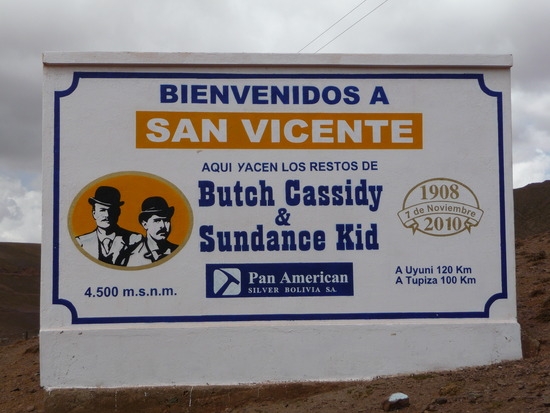 There are some legends there, and mostly in the south of Bolivia around Tupiza, there are a lot of legends. They have two museums about Butch Cassidy and the Sundance Kid. And everybody says that he is kind of a friend of a friend of a friend of Butch Cassidy and the Sundance Kid. And they have these legends, and they have a kind of a love about these two characters. So they always wanted to make a movie about them, but there is no big film industry there. So to make a movie about Butch Cassidy is not an easy task for the Bolivians. So, they were very happy with this movie we made.
There are some legends there, and mostly in the south of Bolivia around Tupiza, there are a lot of legends. They have two museums about Butch Cassidy and the Sundance Kid. And everybody says that he is kind of a friend of a friend of a friend of Butch Cassidy and the Sundance Kid. And they have these legends, and they have a kind of a love about these two characters. So they always wanted to make a movie about them, but there is no big film industry there. So to make a movie about Butch Cassidy is not an easy task for the Bolivians. So, they were very happy with this movie we made.
Were you concerned about the flashbacks being compared to Paul Newman’s iconic Cassidy film?
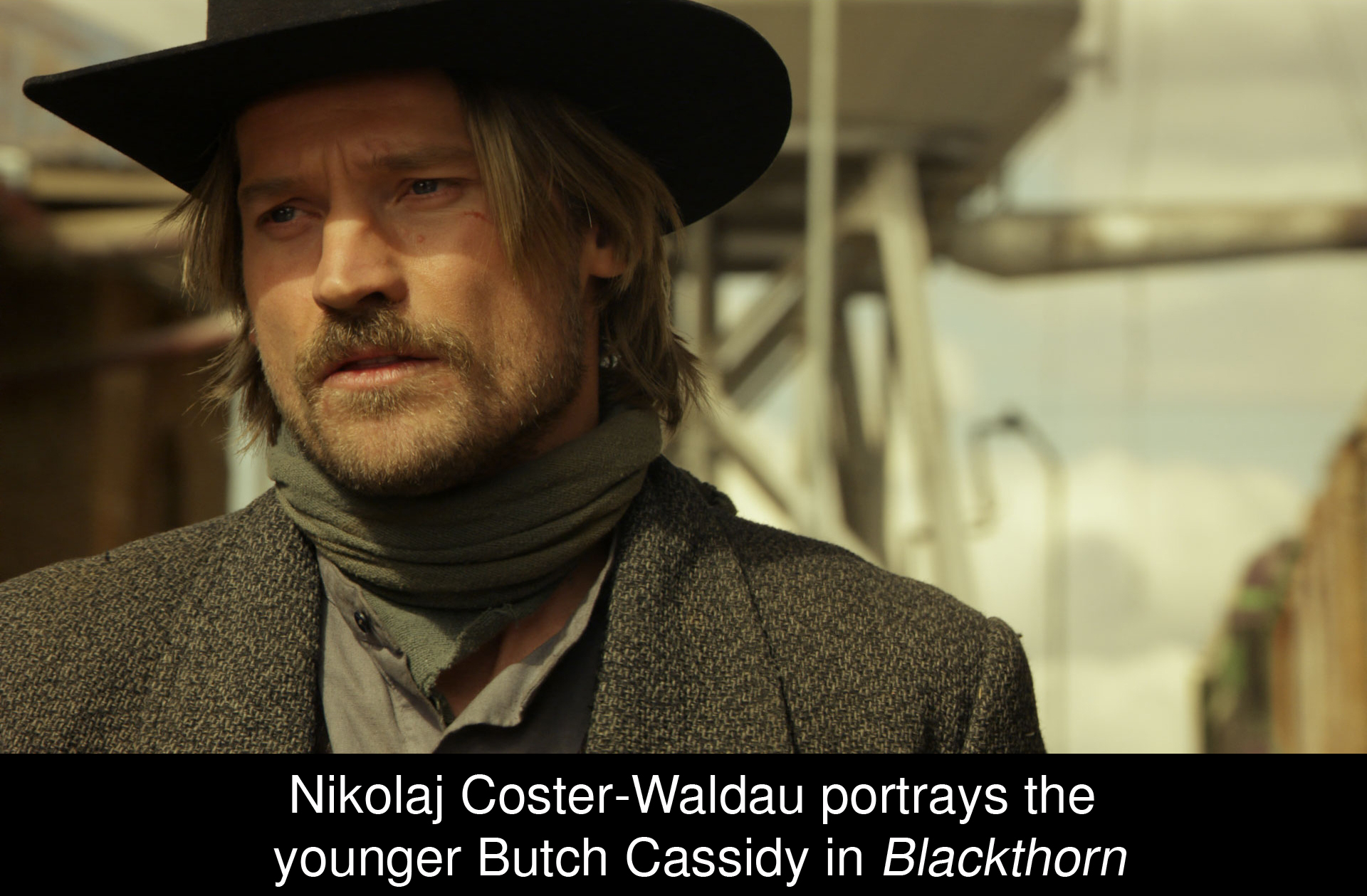 At the beginning, we were very scared about some comments with the news about this movie, before shooting it, that came to the press and the internet. We read that some people were saying things like, “What are these people doing with this wonderful ending of Butch Cassidy and the Sundance Kid? What are they doing now?” We were a little bit afraid about this. But in the end we thought, “This is an homage to this kind of cinema, the old times of cinema, and the old Western heroes.” And nobody is going to be upset with a movie like that. Because if you’ve seen the movie, you can see that Butch Cassidy alive is a kind of excuse to talk about these old Western heroes. So in the end we thought, “I think it’s OK.” But there was this problem with the flashbacks. We wanted the flashbacks in the movie, because through these flashbacks you can get a
At the beginning, we were very scared about some comments with the news about this movie, before shooting it, that came to the press and the internet. We read that some people were saying things like, “What are these people doing with this wonderful ending of Butch Cassidy and the Sundance Kid? What are they doing now?” We were a little bit afraid about this. But in the end we thought, “This is an homage to this kind of cinema, the old times of cinema, and the old Western heroes.” And nobody is going to be upset with a movie like that. Because if you’ve seen the movie, you can see that Butch Cassidy alive is a kind of excuse to talk about these old Western heroes. So in the end we thought, “I think it’s OK.” But there was this problem with the flashbacks. We wanted the flashbacks in the movie, because through these flashbacks you can get a 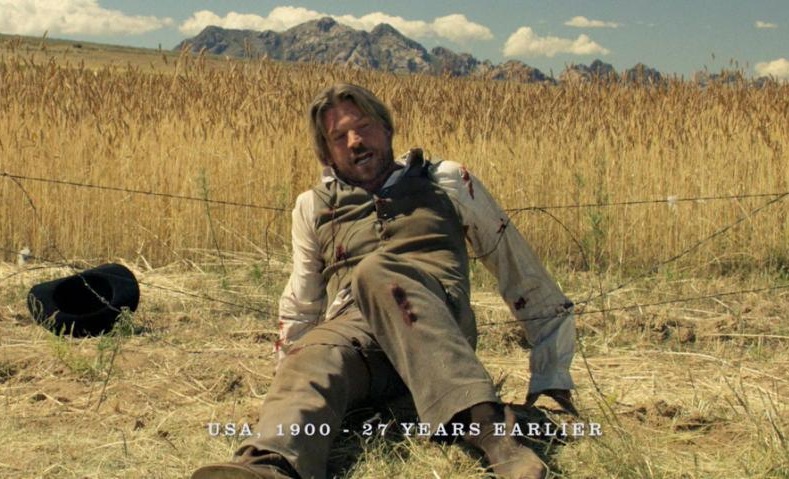 feeling about these old times of freedom, of a strong friendship between them, about principles, about a lot of things that we need the audience to feel in order to understand the story of the present. We knew that these flashbacks had a mood not similar to Butch Cassidy and the Sundance Kid, but you could see some common issues. And it was a little bit risky, but I think that we achieved a nostalgic tone in these flashbacks. And that was the thing that was quite easy with the flashbacks. I don’t know, because I feel that some people don’t like the flashbacks very much, because they are a little bit strange. I understand why, but I wanted the flashbacks to be there to get this feeling. It was very important for me.
feeling about these old times of freedom, of a strong friendship between them, about principles, about a lot of things that we need the audience to feel in order to understand the story of the present. We knew that these flashbacks had a mood not similar to Butch Cassidy and the Sundance Kid, but you could see some common issues. And it was a little bit risky, but I think that we achieved a nostalgic tone in these flashbacks. And that was the thing that was quite easy with the flashbacks. I don’t know, because I feel that some people don’t like the flashbacks very much, because they are a little bit strange. I understand why, but I wanted the flashbacks to be there to get this feeling. It was very important for me.
What effect did 19 years in Bolivia as “James Blackthorn” have on your older Butch Cassidy?
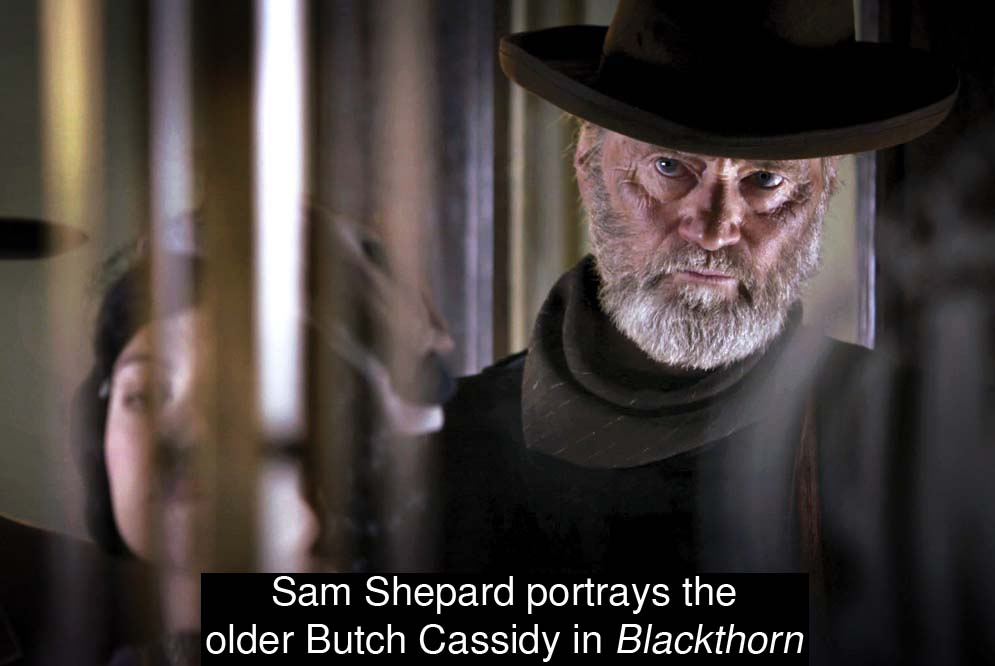 For me, the role of Bolivia and the role of all those years that Sam’s Butch spent in Bolivia is just lonliness, and the relation with his old years. It’s not a movie about Bolivia. Bolivia’s not the main issue. It’s not really a character. The landscape is a kind of visual expression of the character’s feelings, nostalgia, etc. That’s the way I saw this landscape, and the role of Bolivia in the movie. But you know, there is a thing that’s important for me. I always felt that the audiences are so accustomed to seeing great landscapes in movies that we have become immunized to landscapes. We don’t feel landscape anymore. But if you do a western in a kind of similar landscape, and not the same landscape as always, you can achieve a reaction. People see the landscape again, because it’s a
For me, the role of Bolivia and the role of all those years that Sam’s Butch spent in Bolivia is just lonliness, and the relation with his old years. It’s not a movie about Bolivia. Bolivia’s not the main issue. It’s not really a character. The landscape is a kind of visual expression of the character’s feelings, nostalgia, etc. That’s the way I saw this landscape, and the role of Bolivia in the movie. But you know, there is a thing that’s important for me. I always felt that the audiences are so accustomed to seeing great landscapes in movies that we have become immunized to landscapes. We don’t feel landscape anymore. But if you do a western in a kind of similar landscape, and not the same landscape as always, you can achieve a reaction. People see the landscape again, because it’s a 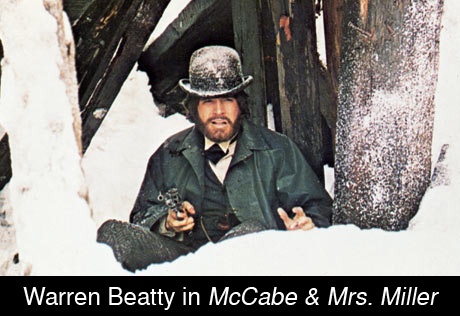 little bit different. It’s like when Robert Altman made this wonderful movie called McCabe & Mrs. Miller. Everything was snow and, with Jeremiah Johnson, it was the first time that you were seeing a Western in a different landscape. It’s the same landscape, but everything is white, and so everything was different. The effect is beautiful, and I thought about these movies when I was choosing the landscapes in Bolivia. I thought, “This is new for all Western audiences.” But at the same time, the landscapes have the same feeling, same loneliness, same nostalgic thing, same dry desert thing. That’s important for me.
little bit different. It’s like when Robert Altman made this wonderful movie called McCabe & Mrs. Miller. Everything was snow and, with Jeremiah Johnson, it was the first time that you were seeing a Western in a different landscape. It’s the same landscape, but everything is white, and so everything was different. The effect is beautiful, and I thought about these movies when I was choosing the landscapes in Bolivia. I thought, “This is new for all Western audiences.” But at the same time, the landscapes have the same feeling, same loneliness, same nostalgic thing, same dry desert thing. That’s important for me.
What was your approach to casting the lead actors for Blackthorn?
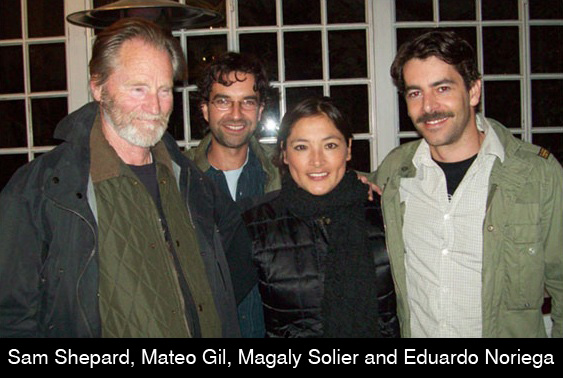 I was very clear that I wanted Sam, and I wanted Eduardo. Then we were very lucky, and we got Stephen Rea also, who’s great. The main problem for us was that the rest of the characters, the three young bandits, should be European. We had European help for the production, but the requisite was that the actors should be European. So we needed three European actors who could do a very good American accent, could ride, and one of them should be very similar to Sam. So it was very difficult to make this casting, but we had a very good English casting director, Jina Jay. She did really good work for us. I think the actors are wonderful in the flashbacks, the three of them. Of course Stephen Rea, we needed him to be European too. But he’s perfect, because he plays an Irish-American. That was our original idea, and he’s amazing.
I was very clear that I wanted Sam, and I wanted Eduardo. Then we were very lucky, and we got Stephen Rea also, who’s great. The main problem for us was that the rest of the characters, the three young bandits, should be European. We had European help for the production, but the requisite was that the actors should be European. So we needed three European actors who could do a very good American accent, could ride, and one of them should be very similar to Sam. So it was very difficult to make this casting, but we had a very good English casting director, Jina Jay. She did really good work for us. I think the actors are wonderful in the flashbacks, the three of them. Of course Stephen Rea, we needed him to be European too. But he’s perfect, because he plays an Irish-American. That was our original idea, and he’s amazing.
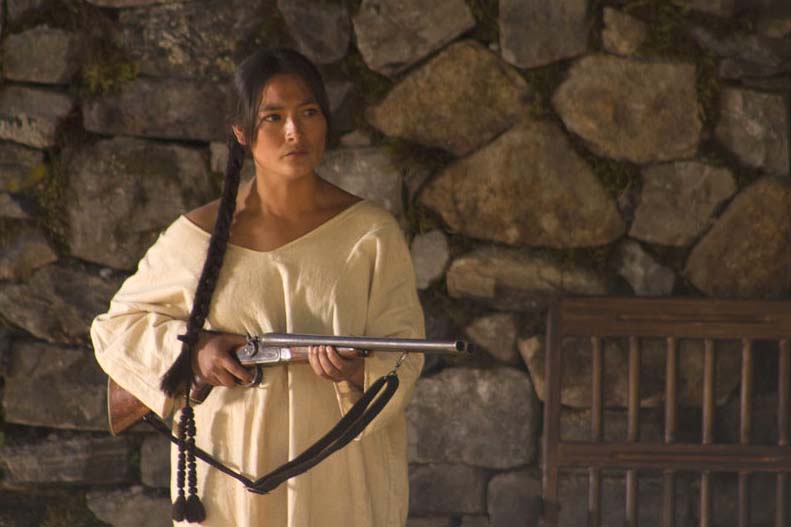 Magaly Solier [Yana] is not Bolivian. She’s actually Peruvian. But you know, she’s very good and I was very confident about her doing a Bolivian accent. And Sam did very OK too. The only thing is that for Bolivian people, the Quechua that she talks is a Peruvian Quechua, so Bolivians say, “What kind of Quechua is this? It’s very weird.” Because it’s Peruvian. But you know her Spanish accent is very Bolivian, and she is great. Her face, her mood, her way of acting. She’s beautiful.
Magaly Solier [Yana] is not Bolivian. She’s actually Peruvian. But you know, she’s very good and I was very confident about her doing a Bolivian accent. And Sam did very OK too. The only thing is that for Bolivian people, the Quechua that she talks is a Peruvian Quechua, so Bolivians say, “What kind of Quechua is this? It’s very weird.” Because it’s Peruvian. But you know her Spanish accent is very Bolivian, and she is great. Her face, her mood, her way of acting. She’s beautiful.
Do you consider Cassidy the film’s hero — given how he abandons Eduardo to the mining posse?
This is a very interesting and difficult question, because I think that it is inevitable that audiences feel close to Butch in this moment. He is the hero, Eduardo is the villain, and everything is all right. But I think if we 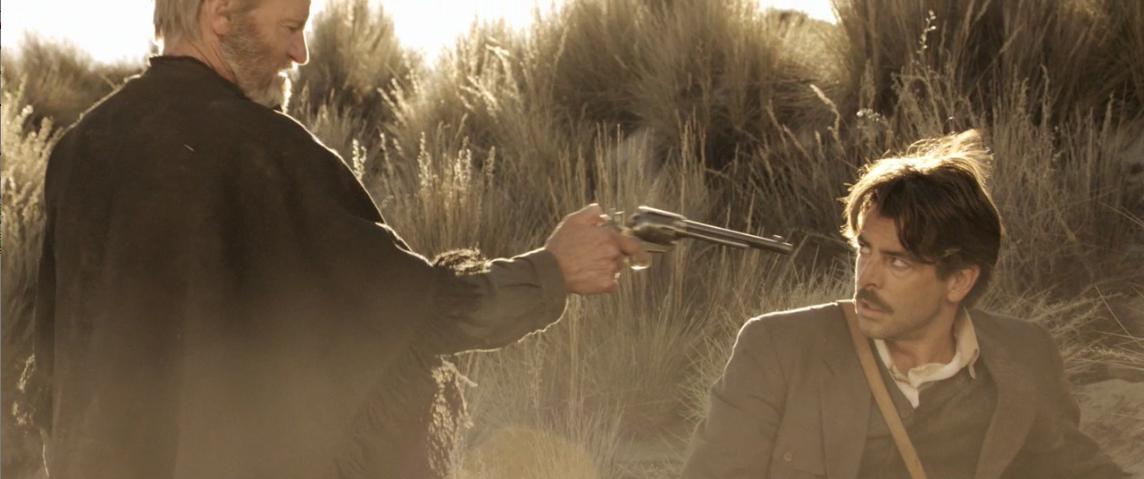 think deep about some of Butch’s decisions, you can find some problems. Because he could have given the money back to the Indians, and he could have saved Eduardo at the same time. For example, he could have freed the horse, but then left Eduardo without a wound. But his shooting Eduardo, letting the horse go free, he’s condemning him to death. So he’s kind of making himself a judge, and I think this is a difficult decision. I don’t think this is the right decision. I think you can think on the contrary, that maybe it’s too much. So I like this ambiguity in this moment. But I don’t know if people are thinking about ambiguity when they see the movie. I think because of the music, because this is the end, because he’s Butch Cassidy — I think people say, “OK, great, great.” But it’s a delicate point this one.
think deep about some of Butch’s decisions, you can find some problems. Because he could have given the money back to the Indians, and he could have saved Eduardo at the same time. For example, he could have freed the horse, but then left Eduardo without a wound. But his shooting Eduardo, letting the horse go free, he’s condemning him to death. So he’s kind of making himself a judge, and I think this is a difficult decision. I don’t think this is the right decision. I think you can think on the contrary, that maybe it’s too much. So I like this ambiguity in this moment. But I don’t know if people are thinking about ambiguity when they see the movie. I think because of the music, because this is the end, because he’s Butch Cassidy — I think people say, “OK, great, great.” But it’s a delicate point this one.
How close to reality are the Indian-controlled collective mines portrayed in this film?
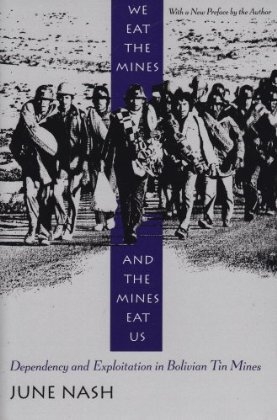 There are no historical facts in the movie, except that there are some doubts about if Butch Cassidy and the Sundance Kid really died in Bolivia in 1908. That’s all. The rest of the story is fiction. About mining, you know the collective mines in Bolivia started a little bit later, around the ’50’s. But in the ’20’s, there was some fights between the miners and the owners. The thing is that there were maybe the biggest silver and tin mines in the world in Bolivia at that time. And Simón Patiño was one of the biggest owners there. He was more powerful and richer than the whole Bolivian country. So there were some fights at this time in the ’20’s, and we invented or suggested in the movie that those fights were successful. But they weren’t in the real history, until the ’40’s and ’50’s. The owners owned the mines, not the miners — never the miners, until the ’50’s. So that’s all. We tried to make a kind of Utopian reality in this movie, but the real reality was a little bit harder. But you know, that movie came in a time when there was a new hope in Bolivia with Evo Morales. Because Evo, he is from Oruro. That is one of the biggest places with mines in Bolivia. Actually, the mine that Eduardo robbed in this movie is a mine in Oruro. So it was a good time to make a movie like this, because mines now are owned by the miners. The thing is that mines now are very small mines, because they are exhausted. But they work, and they have a meaningful life there now.
There are no historical facts in the movie, except that there are some doubts about if Butch Cassidy and the Sundance Kid really died in Bolivia in 1908. That’s all. The rest of the story is fiction. About mining, you know the collective mines in Bolivia started a little bit later, around the ’50’s. But in the ’20’s, there was some fights between the miners and the owners. The thing is that there were maybe the biggest silver and tin mines in the world in Bolivia at that time. And Simón Patiño was one of the biggest owners there. He was more powerful and richer than the whole Bolivian country. So there were some fights at this time in the ’20’s, and we invented or suggested in the movie that those fights were successful. But they weren’t in the real history, until the ’40’s and ’50’s. The owners owned the mines, not the miners — never the miners, until the ’50’s. So that’s all. We tried to make a kind of Utopian reality in this movie, but the real reality was a little bit harder. But you know, that movie came in a time when there was a new hope in Bolivia with Evo Morales. Because Evo, he is from Oruro. That is one of the biggest places with mines in Bolivia. Actually, the mine that Eduardo robbed in this movie is a mine in Oruro. So it was a good time to make a movie like this, because mines now are owned by the miners. The thing is that mines now are very small mines, because they are exhausted. But they work, and they have a meaningful life there now.
What effect did Bolivia’s altitude have on your location shooting?
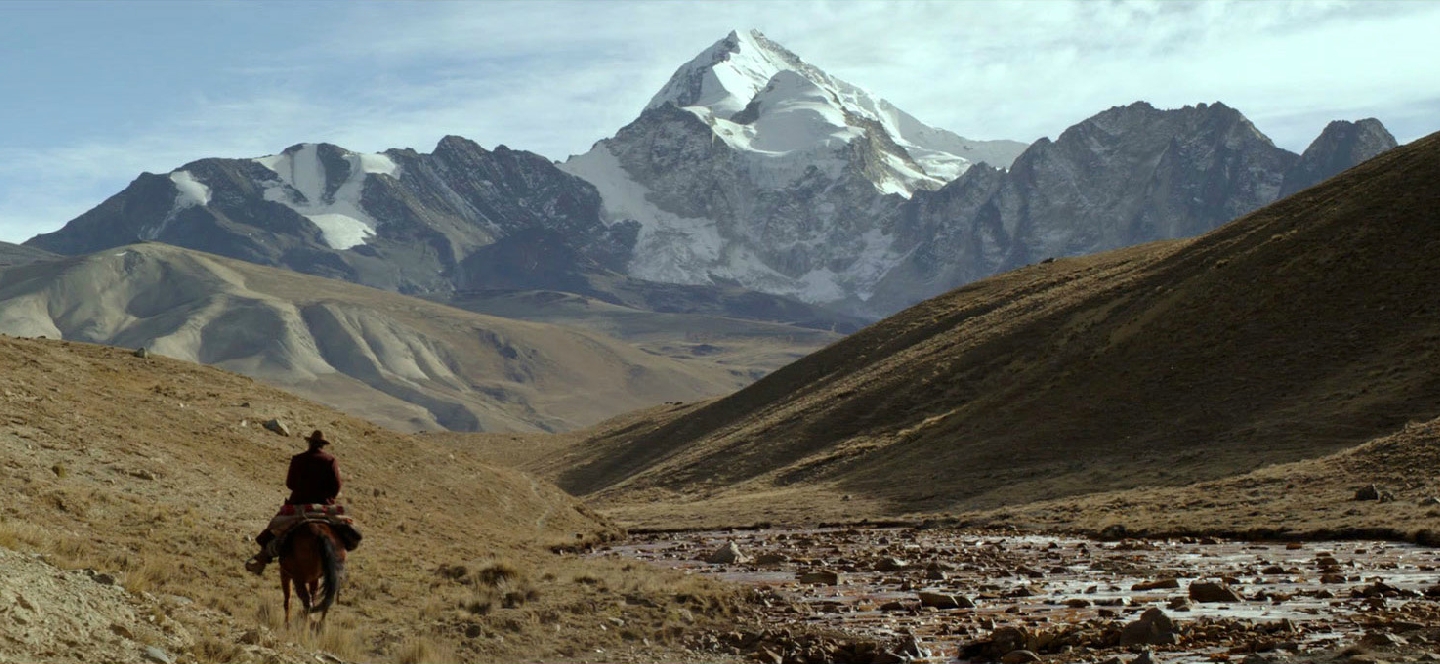 The whole movie is shot in the high plateau. All the locations were between 12,000 and 15,000 feet high — all the locations, except the location of the ranch. This location is very near the high plateau, and very close to the capital, LA Paz. But it’s in the descent from the high plateau to the Amazon area. So it’s a really high descent, because you go from more or less 15,000 feet high, down to 900 feet high. So the ranch is in the middle, around 7,000 to 8,000 feet high. And this is the greenest part of the movie, because it’s a very wet area. Actually, you can see in the movie that sometimes there is a kind of fog in the ranch, because we had a
The whole movie is shot in the high plateau. All the locations were between 12,000 and 15,000 feet high — all the locations, except the location of the ranch. This location is very near the high plateau, and very close to the capital, LA Paz. But it’s in the descent from the high plateau to the Amazon area. So it’s a really high descent, because you go from more or less 15,000 feet high, down to 900 feet high. So the ranch is in the middle, around 7,000 to 8,000 feet high. And this is the greenest part of the movie, because it’s a very wet area. Actually, you can see in the movie that sometimes there is a kind of fog in the ranch, because we had a 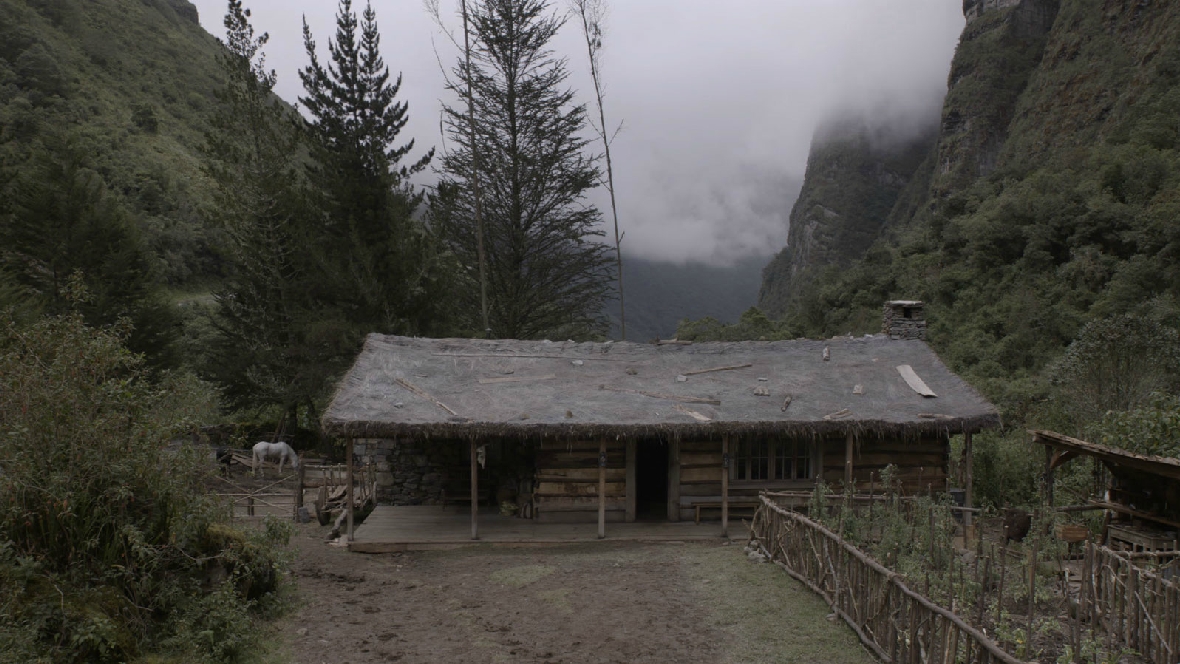 few problems with the fog during our filming — with the shootout at the ranch, for example. The weather changes every minute in this place, because the clouds are always at your height more or less. The rest of the movie is shot in the high plateau. The lowest part was the Uyuni salt flats, around 12,000 feet high, and the highest place is the place where the military official leaves MacKinley alone at the end of the movie. That was around 15,000 feet high — and the place where the Sundance Kid dies with the snow. And the high plateau is a very deserted place, but it’s beautiful. Every time you cross a valley and you see another one, it’s more beautiful than the one before. And the sad thing is that we
few problems with the fog during our filming — with the shootout at the ranch, for example. The weather changes every minute in this place, because the clouds are always at your height more or less. The rest of the movie is shot in the high plateau. The lowest part was the Uyuni salt flats, around 12,000 feet high, and the highest place is the place where the military official leaves MacKinley alone at the end of the movie. That was around 15,000 feet high — and the place where the Sundance Kid dies with the snow. And the high plateau is a very deserted place, but it’s beautiful. Every time you cross a valley and you see another one, it’s more beautiful than the one before. And the sad thing is that we 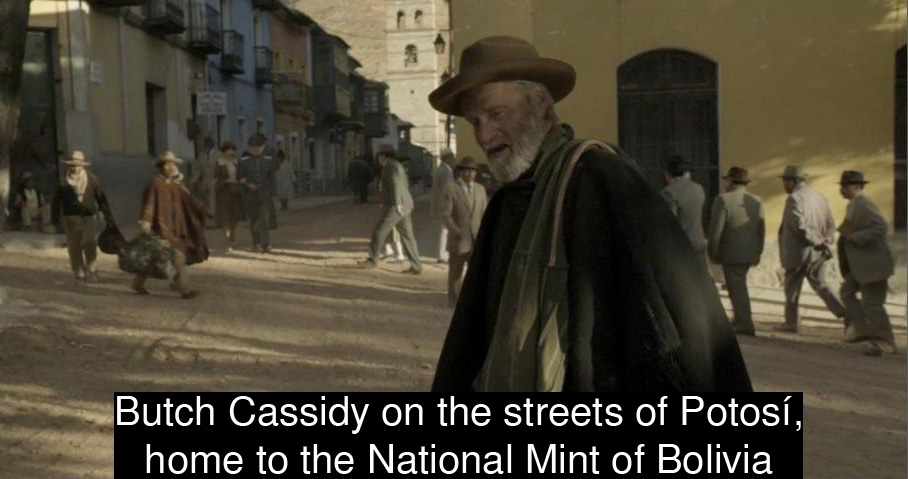 saw a lot of places in the high plateau, but we had to join the locations around the places where we could stay. So big cities, no small towns. So all the locations are around La Paz, the capital; Potosí, the mining place with the mountain that is a mine; and Uyuni, a place that is beside the Uyuni salt flats. This is a small town, but they have a lot of hotels because of the tourist thing around the Uyuni salt flats. But we lost a lot of places that were far enough away to be too dangerous to go to, or too wasteful.
saw a lot of places in the high plateau, but we had to join the locations around the places where we could stay. So big cities, no small towns. So all the locations are around La Paz, the capital; Potosí, the mining place with the mountain that is a mine; and Uyuni, a place that is beside the Uyuni salt flats. This is a small town, but they have a lot of hotels because of the tourist thing around the Uyuni salt flats. But we lost a lot of places that were far enough away to be too dangerous to go to, or too wasteful.
We didn’t have much money for this movie, so Bolivia was a good opportunity to make it, because if you choose the places well, you can find some places that they keep like 100 years ago. For 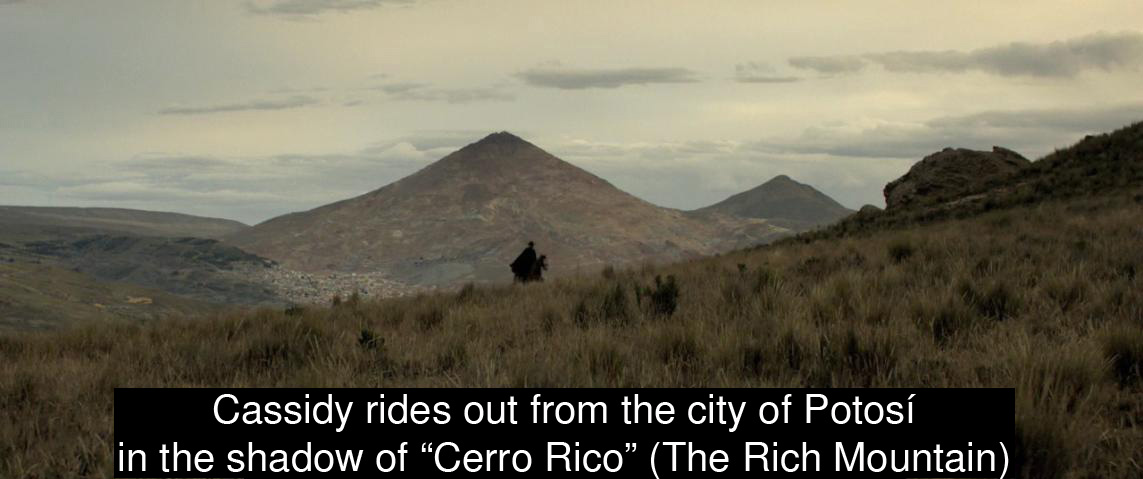 this scene in Potosí, we chose the street that allowed us to see the mountain that is the historic mine. And that was old enough to make a good deal for the movie. We had to change some things and paint some things, but it’s almost like now, this street. And we erased some of the houses in the background digitally, and some telephone lines. But this street is almost like it was then. The rest of the places — Tupiza, the little village and everything — it’s almost untouched.
this scene in Potosí, we chose the street that allowed us to see the mountain that is the historic mine. And that was old enough to make a good deal for the movie. We had to change some things and paint some things, but it’s almost like now, this street. And we erased some of the houses in the background digitally, and some telephone lines. But this street is almost like it was then. The rest of the places — Tupiza, the little village and everything — it’s almost untouched.
During the shooting in the Uyuni salt flats, we stayed in three or four hotels that are in the shore — hotels that are made of salt. It’s beautiful. Normally, people go there for two days and then leave. So they spend two days in the hotels, but we spent seven to ten days in the Uyuni hotels. 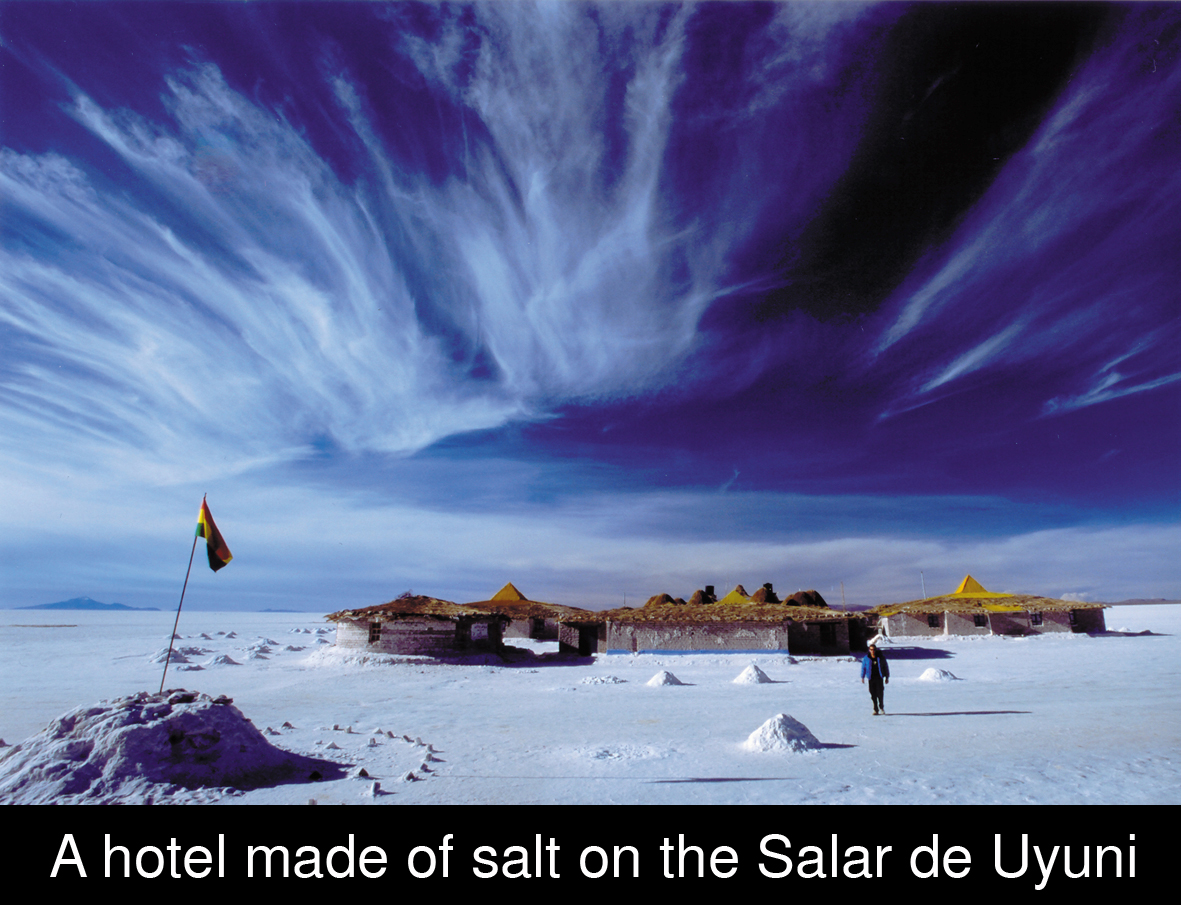 So they were kind of overwhelmed in the hotels, because there were a lot of people at the same time. And after the shooting every day, everyone was running back to the hotel, because the first that came to the hotel could have a hot shower. But the last, he had to have a cold shower — and the water is very, very cold. Actually it’s very cold on the Uyuni salt flats. The problem was that when the rainy season starts, the Uyuni flats get flooded for three or four months. You cannot get in there with a car, because you are not going to survive. So, we couldn’t go to the salt flats before the shooting to test anything. And then when the salt flats got dry, we went there to shoot, so it was very risky with cameras and everything. But we were very lucky. Everything worked perfectly well.
So they were kind of overwhelmed in the hotels, because there were a lot of people at the same time. And after the shooting every day, everyone was running back to the hotel, because the first that came to the hotel could have a hot shower. But the last, he had to have a cold shower — and the water is very, very cold. Actually it’s very cold on the Uyuni salt flats. The problem was that when the rainy season starts, the Uyuni flats get flooded for three or four months. You cannot get in there with a car, because you are not going to survive. So, we couldn’t go to the salt flats before the shooting to test anything. And then when the salt flats got dry, we went there to shoot, so it was very risky with cameras and everything. But we were very lucky. Everything worked perfectly well.
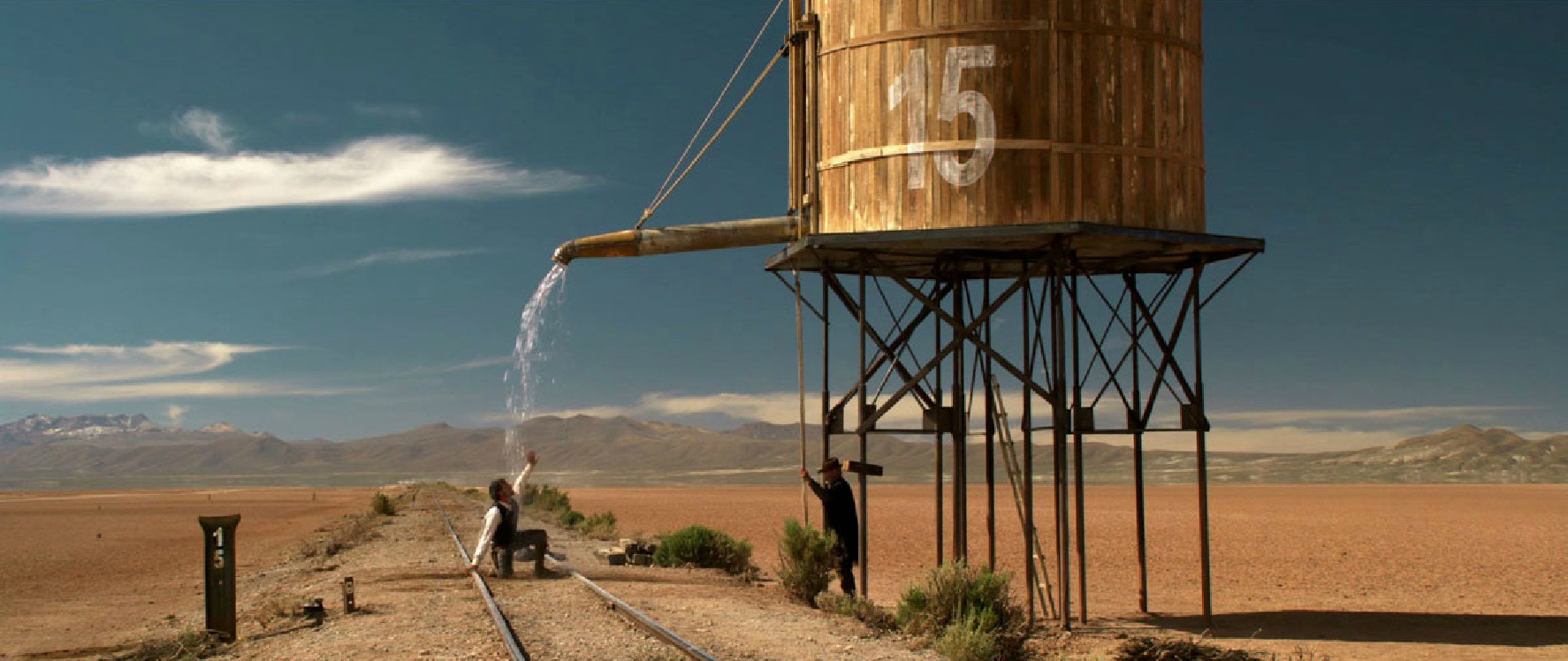 We were very tired. But if you spend around two weeks in the high plateau, then you get more or less adapted. You cannot run, but you can do more or less OK. There are people that feel really sick. So you can have this altitude sickness, but we were very lucky. The only one that had problems with the altitude was, strangely enough — maybe because he was the strongest person in the crew — was an Argentinian stuntman that was actually Shepard’s double. And he was very strong, but he had problems with the altitude. Two or three times he went to the hospital. Because when you feel sick, you have to go down very quickly and go to the hospital, and you recover very well. But you have to go down very quickly.
We were very tired. But if you spend around two weeks in the high plateau, then you get more or less adapted. You cannot run, but you can do more or less OK. There are people that feel really sick. So you can have this altitude sickness, but we were very lucky. The only one that had problems with the altitude was, strangely enough — maybe because he was the strongest person in the crew — was an Argentinian stuntman that was actually Shepard’s double. And he was very strong, but he had problems with the altitude. Two or three times he went to the hospital. Because when you feel sick, you have to go down very quickly and go to the hospital, and you recover very well. But you have to go down very quickly.
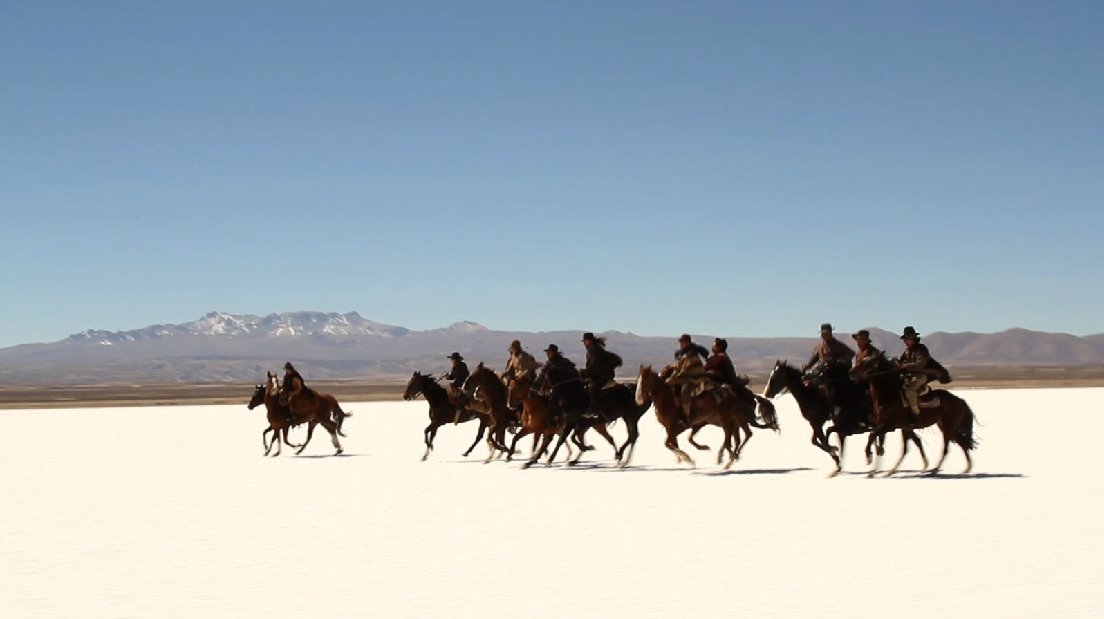 We didn’t find horses in the high plateau. The only horses we found there were the military horses, but we could use them just one day. So we had to bring horses from Argentina and from South Bolivia — from the Amazonian part of Bolivia — a month before the shooting started, because the horses needed to be adapted to the altitude. Actually I was very scared, because we didn’t have time to test the horses properly. And I was most afraid about the Uyuni salt flats, because the problem there is not only the altitude, but the solar radiation. It’s very, very dangerous. So if you see the movie, you could see that the horses are blinded with clothes. That was my idea, because I didn’t want the horses to get crazy, or to go blind. And my idea was also that the characters were blinded.
We didn’t find horses in the high plateau. The only horses we found there were the military horses, but we could use them just one day. So we had to bring horses from Argentina and from South Bolivia — from the Amazonian part of Bolivia — a month before the shooting started, because the horses needed to be adapted to the altitude. Actually I was very scared, because we didn’t have time to test the horses properly. And I was most afraid about the Uyuni salt flats, because the problem there is not only the altitude, but the solar radiation. It’s very, very dangerous. So if you see the movie, you could see that the horses are blinded with clothes. That was my idea, because I didn’t want the horses to get crazy, or to go blind. And my idea was also that the characters were blinded. 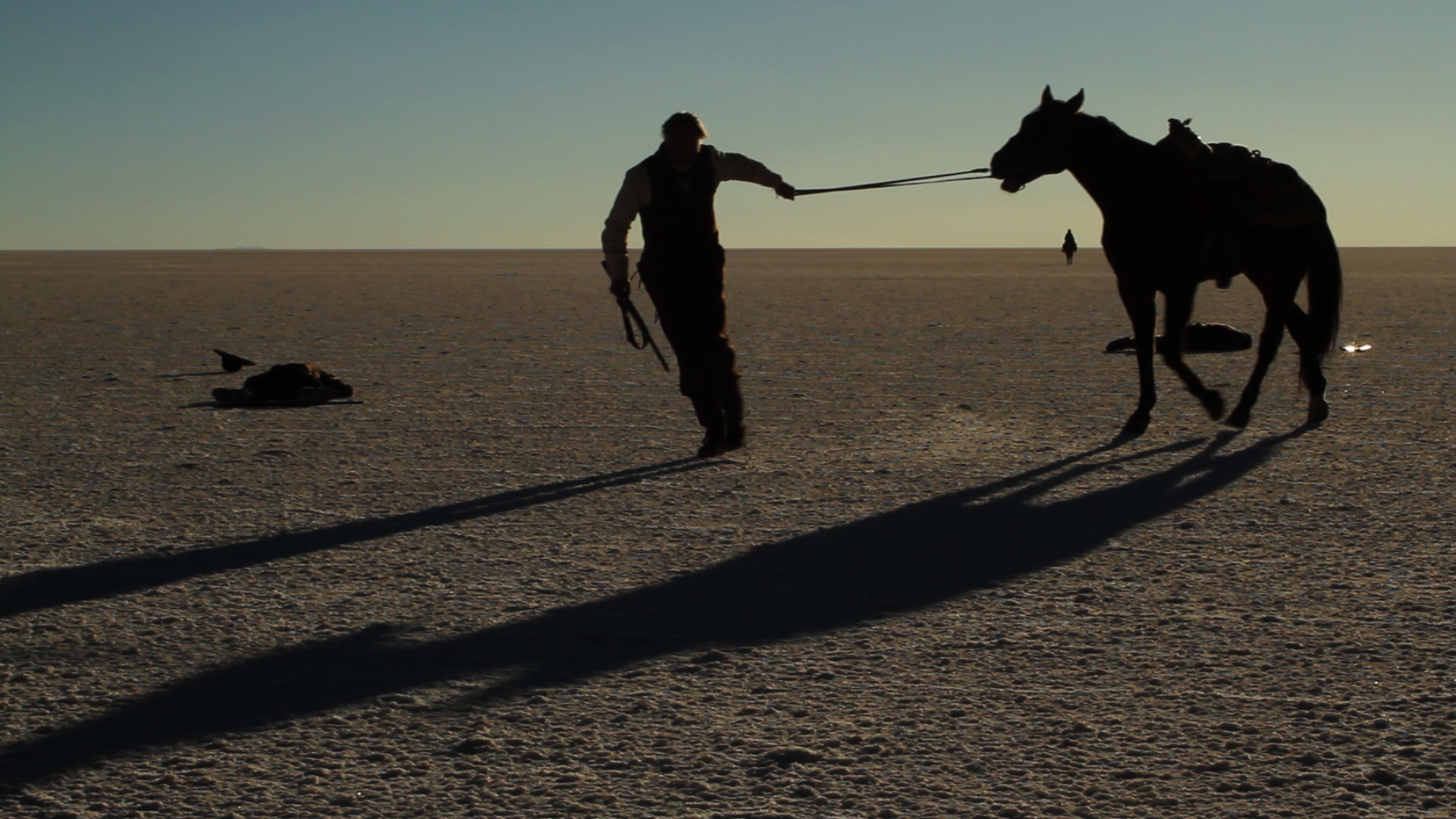 Actually, with the first scene in the Uyuni salt flats, Eduardo is blinded. But we couldn’t test before the shooting, so we started shooting with this. And then Sam told me, “This is too dangerous for me. I think that I could fall from the horse, because I can’t see very well.” So in the end we took it off from the characters, but not from the horses. I was afraid about horses getting nervous or crazy or very tired. But in the end, everything went very OK in the Uyuni salt flats.
Actually, with the first scene in the Uyuni salt flats, Eduardo is blinded. But we couldn’t test before the shooting, so we started shooting with this. And then Sam told me, “This is too dangerous for me. I think that I could fall from the horse, because I can’t see very well.” So in the end we took it off from the characters, but not from the horses. I was afraid about horses getting nervous or crazy or very tired. But in the end, everything went very OK in the Uyuni salt flats.
What was the value of shooting Blackthorn on location, compared to filming Agora in Malta?
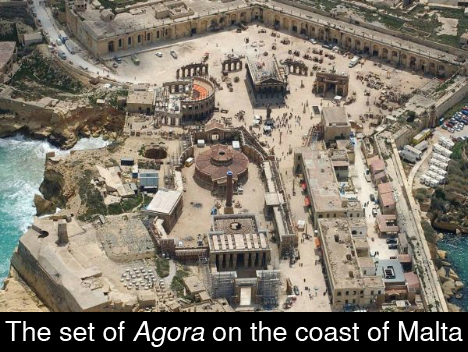 In the case of Agora, it was a very expensive movie for Spain. In the case of Blackthorn, the problem was that it was a very cheap movie for Spain, and everywhere else. So for Agora, they analyzed the opportunities in Egypt, the opportunities in Morocco, the opportunities in Spain. And in the end, the place that allowed them the greatest quantity of facilities, hotels, and help was Malta. Because there was an old Medieval fortress that served as a background for the whole city. So you are seeing the sets, and always in the background there is a kind of city landscape, but that’s the fortress. So it was very useful, and they found a lot of places around it where they could make a lot of things. So, it was a good place to shoot. It was not very expensive. For example, they shot Gladiator there too with the same trick in the backgrounds, so it was a kind of good trick. In the case of Blackthorn, the producer and I made a trip in the beginning to Bolivia, but we didn’t go there just to choose the places. We went there to decide if it was possible to shoot in Bolivia. Because the high plateau doesn’t have good hotels, doesn’t have good roads — everything is difficult. They don’t have any cinema industry there, so we had to bring everything from outside. It was difficult. And we traveled around the high plateau, and we said, “OK, it’s impossible to shoot the movie here. It’s impossible. But we cannot do it any other place. So we have to get prepared to cut things, to make difficult decisions, to do a lot of stupid things. But we have to do it here, because this landscape is the best we can achieve for this movie.”
In the case of Agora, it was a very expensive movie for Spain. In the case of Blackthorn, the problem was that it was a very cheap movie for Spain, and everywhere else. So for Agora, they analyzed the opportunities in Egypt, the opportunities in Morocco, the opportunities in Spain. And in the end, the place that allowed them the greatest quantity of facilities, hotels, and help was Malta. Because there was an old Medieval fortress that served as a background for the whole city. So you are seeing the sets, and always in the background there is a kind of city landscape, but that’s the fortress. So it was very useful, and they found a lot of places around it where they could make a lot of things. So, it was a good place to shoot. It was not very expensive. For example, they shot Gladiator there too with the same trick in the backgrounds, so it was a kind of good trick. In the case of Blackthorn, the producer and I made a trip in the beginning to Bolivia, but we didn’t go there just to choose the places. We went there to decide if it was possible to shoot in Bolivia. Because the high plateau doesn’t have good hotels, doesn’t have good roads — everything is difficult. They don’t have any cinema industry there, so we had to bring everything from outside. It was difficult. And we traveled around the high plateau, and we said, “OK, it’s impossible to shoot the movie here. It’s impossible. But we cannot do it any other place. So we have to get prepared to cut things, to make difficult decisions, to do a lot of stupid things. But we have to do it here, because this landscape is the best we can achieve for this movie.”